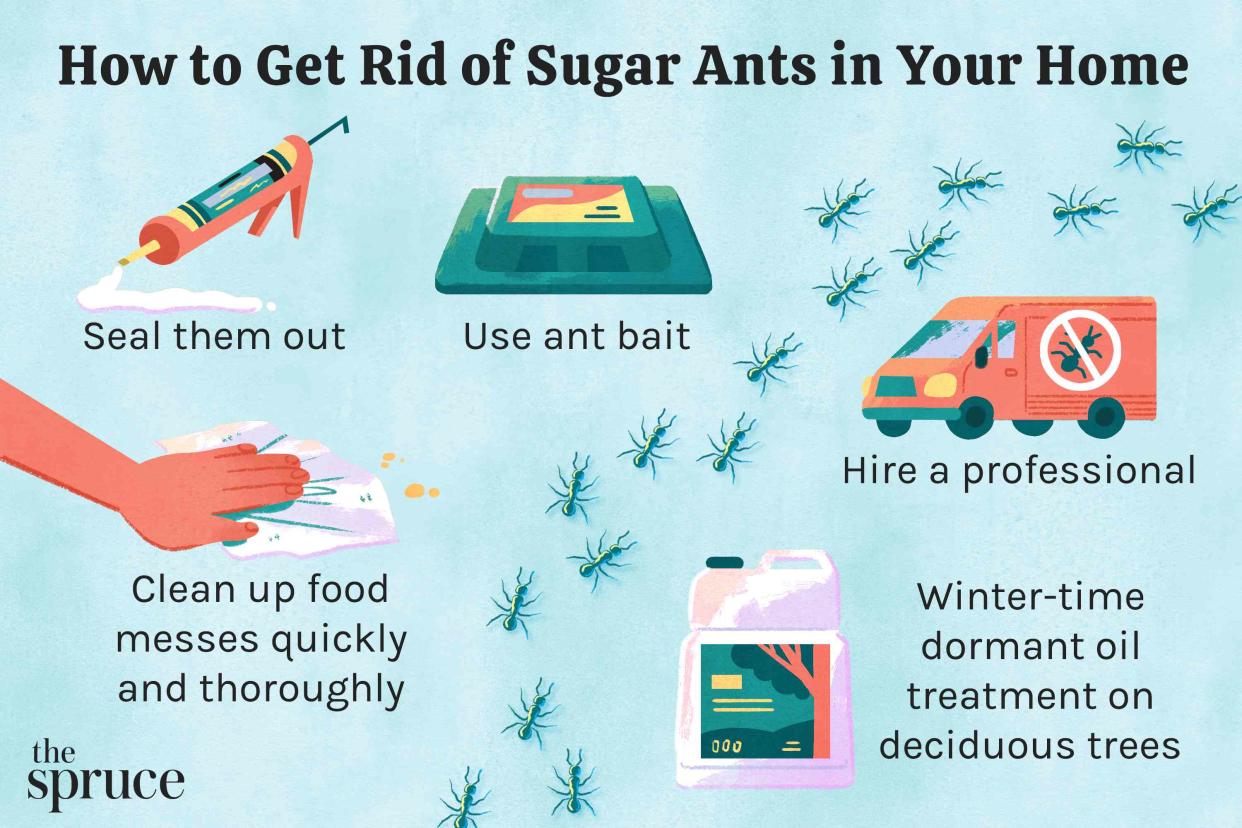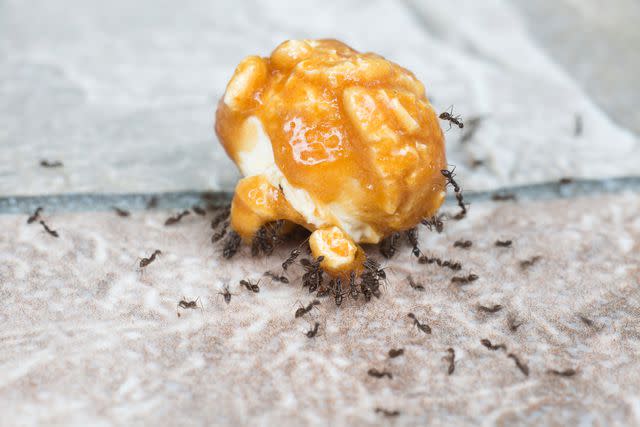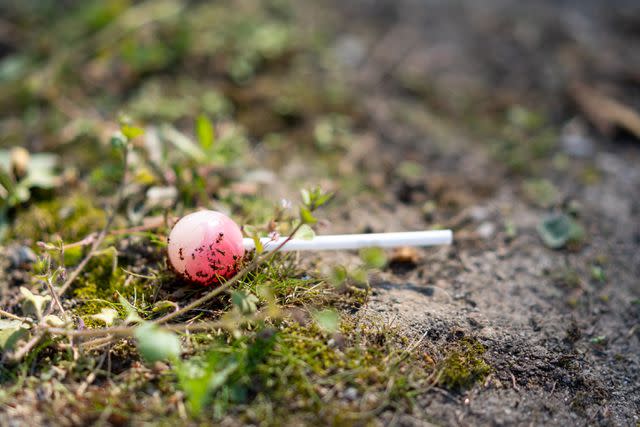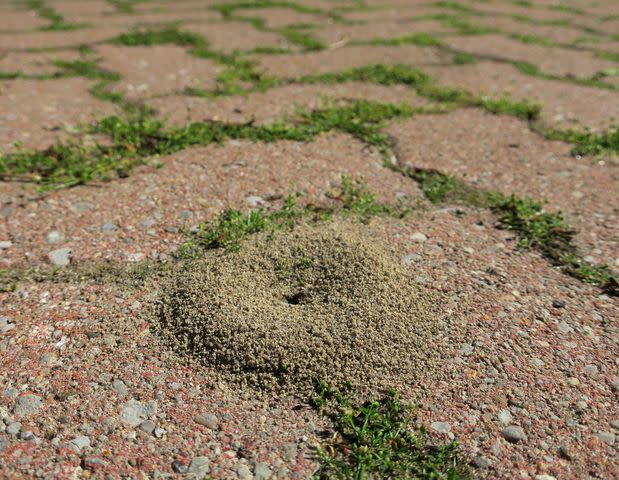How to Get Rid of Sugar Ants in Your Home

The Spruce / Theresa Chiechi
Reviewed by Amanda Rose NewtonFact checked by Sarah Scott
Sugar ants are a common, home-invading, headache-causing pest. Known to pest professionals as the odorous house ant (Tapinoma sessile), they do not sting and rarely bite but can invade homes in large numbers in search of food, especially after rainy weather.
Small in size, sugar ants are budding ants that don't pose any particular risks—but their steady lines, large numbers, and desire for sweets can be annoying to deal with, especially if your home or neighborhood is prone to ongoing sugar ant issues.
What is a Budding Ant?
While certain ant colonies have only one queen, budding ant species (like true sugar ants) have multiple queens that are friendly to each other. The colony uses multiple queens as a means of reproduction and protection. The process of 'budding' occurs when one (or more) queens leaves with a group of workers to establish a nest of their own somewhere else.
What Do Sugar Ants in Your Home Look Like?
There are many types of ants that might pop up inside your home (or car), and ants can be very tricky to identify. In certain situations, a microscope and a trained eye are the only definite means of identification. Even if the ants you're noticing are getting into something sweet, this doesn't guarantee a sugar ant problem.
Sugar ants have the following characteristics:
Small, 2.5-3mm in length
Black to brown in color
Have a distinct, "rotten-coconut" smell when crushed
12 distinct antennae segments
Keep in mind, incorrect identification of ants is very easy. While sugar ants (also known as odorous house ants or OHAs) have these characteristics, they are easily confused with other species. If you want a definitive identification, it would be best to contact a local pest control company specializing in Integrated Pest Management (IPM). They'll be able to help identify the issue and advise on the best treatment options.
5 Ways to Get Rid of Sugar Ants in Your Home
Warning
Sugar ants are widespread. Over-the-counter ant sprays are repellant products and are not well suited for the control of budding ants like sugar ants. Over-the-counter sprays can cause fracturing in budding ant colonies, which will likely result in the problem getting worse over time.
Seal Them Out
Whenever possible, seek to seal up cracks that could allow pests such as ants to enter your home. This could involve caulking in areas such as:
Around windows
In bathrooms
Near exterior doors
Along baseboards
Also make sure that exterior door sweeps and window screens are fitted well, undamaged, and well-secured.
Tip
Think about your home's pest history. Has your property been plagued with sugar ants year after year? Sealing up cracks and crevices is especially important if your home has had an ongoing interior ant issue.
Reduce Food Sources
An important step in any pest control program is seeking to eliminate possible food sources pests could be accessing.
Sugar ants, as their name implies, have a real sweet tooth. They will go out of their way to track down the sweetest of snacks. If you are noticing sugar ants inside your home, make sure that you are cleaning up any food messes quickly and thoroughly to avoid food accumulations that could attract more ants.
Sugar ants also love honeydew, which can be found on the branches of deciduous trees where aphids are present and produce lots of honeydew for ants to enjoy. If you have a regular pest control provider, ask if they perform winter-time dormant oil treatments. These treatments can reduce spring aphid populations, thus reducing surrounding ant activity.
Once sugar ants (odorous house ants) have found a food source, they will signal other ants in the colony that a verified food source has been identified. If you see a dense trail of ants coming and going inside, try to follow them and identify what it is they might be feasting on. It could be something as simple as some crumbs under the couch.

ABimagestudio
Use Ant Bait
When it comes to sugar ant activity, over-the-counter sprays are a no-no, but over-the-counter baits like TERRO stations are a yes. Understand that baits may not be effective enough to kill off an entire colony, but they can be very handy in drawing ants away from high-traffic areas.
Baits are sweet and formulated to attract ants to them. Keep this in mind when deciding where to place your ant bait. For example, if you're seeing ants trailing here and there on your counters, poke around and try to find where they're trailing from. If you discover they are coming from under the sink, place your station under the sink as opposed to on the counter top, where ants can feed on the poison and you don't have to see them in your cooking spaces.
Hire a Professional
Due to the fact that sugar ants are a budding ant, it's important to hire an experienced professional if chemical treatment is needed. Not only will a professional be able to help positively identify the ants you're dealing with, they'll know exactly what products to use (or not to use).
Be sure to have realistic expectations. If you have sprayed an over-the-counter repellant without knowing any better, or if the sugar ant issue is especially severe, it may take more than one treatment to get a handle on things.
Be Patient
Have ants recently popped up inside your home? If so, there could be a few causes. Has your area recently experienced rainy weather? Did you overwater your garden? Sugar ants spend a lot of time outside foraging for honeydew. During rains or watering, ants are flushed out of the soil, and honeydew is washed out of the surrounding plants. This could lead to sugar ants moving inside in search of food.
Make sure your unwanted ant guests don't have access to any food sources and wait until the weather dries out a bit. It's possible this ant activity is temporary and will go away on its own.
Signs of Sugar Ants in Your Home
The most obvious sign of sugar ants inside the home is active trailing. Unless active trails are noticed, it can be easy to miss a sugar ant issue, even when the nest is close nearby or even inside the home.
Outside, sugar ants (odorous house ants) are likely to be found nesting:
Under stones
Around walkways
Beneath boards
Consider what time of year it is and rate the severity of the issue. Is it frequent and severe? Just a few here or there? If you are noticing an interior sugar ant issue and it is wintertime, this is definitely cause for concern. This could mean that you have an ant nest that has moved inside to overwinter.
Inside, sugar ants like heat and can be found nesting in places like:
Under flooring
Near water heaters
Around copper pipes
What Causes Sugar Ants in Your Home?
There are lots of reasons that sugar ants might be popping up in your home.
These could include:
The arrival of warm weather
A nest nearby (outside or inside)
An attractant (food source)
Recent rainy weather or garden watering
If sugar ants have suddenly popped up inside, be patient and wait a day or two to see what the activity does. If they are bothering you, use ant baits to draw the ants from high traffic areas and observe whether the activity dies down on its own.
How to Keep Sugar Ants Away From Your Home
There are lots of easy, low-risk solutions that will help prevent interior ant issues. First, make sure cracks and crevices around your home area sealed up, especially in areas where. you've seen sugar ants trailing.
Seek to reduce possible food sources, including sweet food crumbs. Have a local pest control company treat for aphids during the winter, which will reduce springtime honeydew sources available to sugar ants. Hide bait stations in discreet areas to draw ants away from high-traffic areas.
If long-term ant control is something you feel is needed around your home, find a trusted local pest control company. They will formulate a plan specific to your property's needs and treat it according to the biology of the pest(s) present.
Sugar Ant vs. Pavement Ant
Ant identification can be tricky. Sugar ants are regularly confused for a variety of ants including pavement ants. Both are small and brown, making it tricky to positively i.d. them unless you know exactly what to look for.
One way to tell between these pests? Nodes. Nodes are small lumps on the back (abdomen) of ants. Sugar ants have a single node, where pavement ants have two. This is the easiest way to tell these lookalikes apart, but they are very small and can be difficult to see. It's always best to get a second opinion if you want to be 100% sure.
Sugar Ants
2.5-3mm long
Brown to black in color
Single node on back
12 antennae segments with no club
Distinct odor when crushed
Pavement Ants
2.5-3mm long
Light brown to black in color
Two nodes on back
12 antennae segments with 3 segment club
Leaves mounds of sand on patios

DanielAlbach

Chris Jongkind
Pavement ants push mounds of dirt into the sun to warm, marking entrances to their nests.Frequently Asked Questions
Where do sugar ants come from?
Sugar ants (also called odorous house ants or OHAs) are a very common household pest that are found throughout North America, from Canada to Mexico, and everywhere in between. In short, sugar ants are around and they're not going away anytime soon. If you're concerned about sugar ants, have a plan to keep them outside where they belong without over-applying harmful chemicals.
Will sugar ants go away on their own?
Yes and no. If it has been rainy or you have recently watered your yard or garden, it's possible that sugar ants are popping up inside because they have been flushed out of the soil and plants nearby. If sugar ants are super active inside and they have been for a while, they're probably not going to go away on their own. In this situation, it's probably time to call in the pros.
Do sugar ants bite?
Sugar ants do not sting and do not pose any specific health or structural risks for humans. They may defend themselves when disturbed by using their mouthparts to bite. This is not painful nor will it produce symptoms. That being said, they can be a serious nuisance that can show up in large and persistent numbers inside.
How long do sugar ants live?
With 100-10,000 ants in one colony, the sugar ant life-cycle can take anywhere from five weeks to seven months depending on the temperature and time of year. Workers and female ants can live for several years under the right conditions. Male ants, however, die within a few days of emerging.

